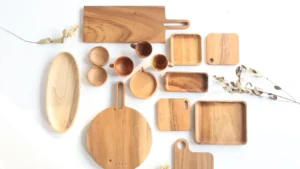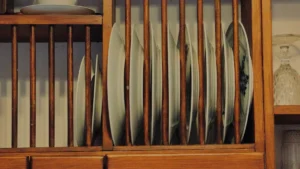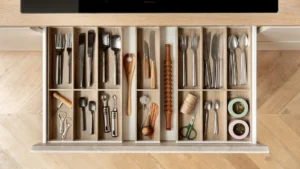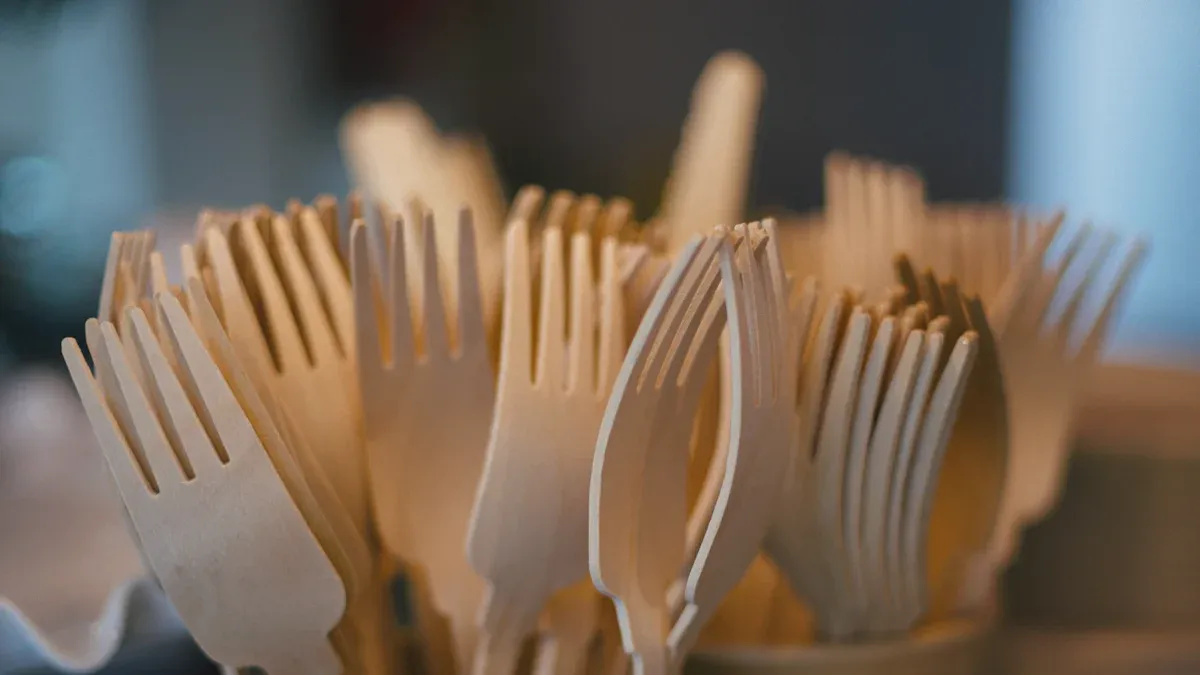
When you choose bamboo plates and cutlery, you help reduce plastic waste. Bamboo plates and cutlery break down naturally, so they do not linger in landfills or oceans. Many people see bamboo as a sustainable alternative because bamboo grows quickly and uses fewer resources. Switching to bamboo plates helps you make an eco-friendly choice every day. Eco-friendly products like bamboo plates and cutlery support a cleaner planet. You can make a big difference by switching to bamboo plates and cutlery. Many families now use bamboo as their sustainable alternative to plastic. Eco-friendly options like these matter for our earth. [“bamboo plates and cutlery”] give you a real way to help.
The Problem with Plastic Tableware
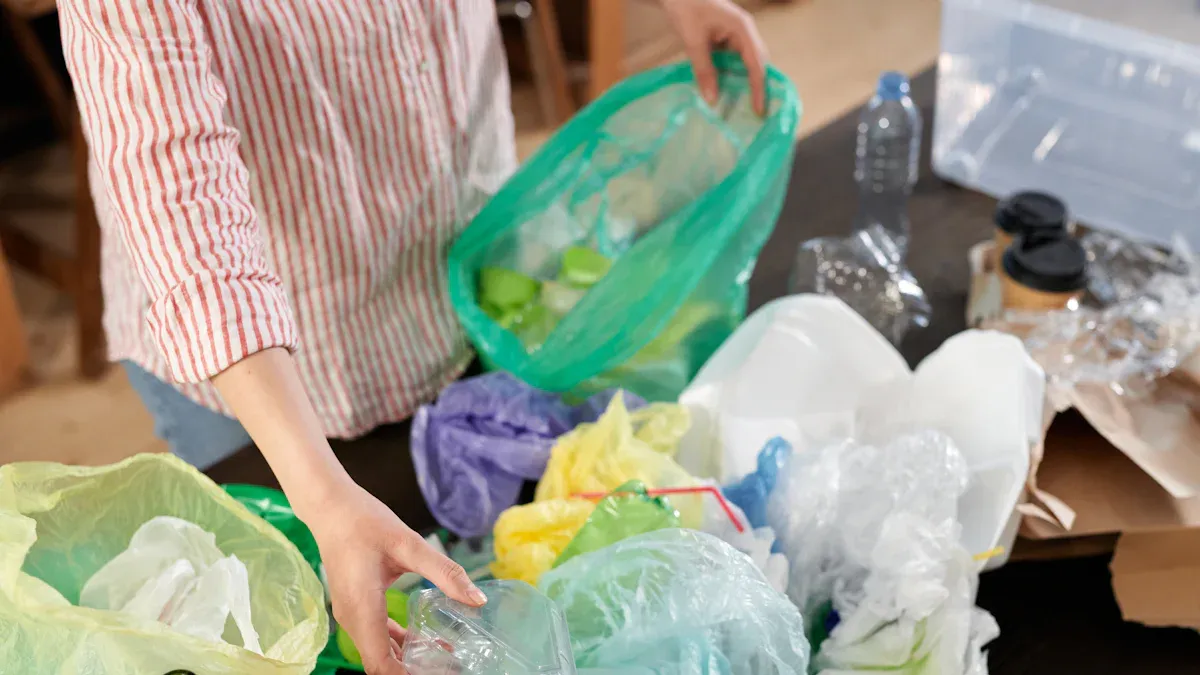
Pollution from Single-Use Plastics
You see disposable plates everywhere—at parties, picnics, and fast-food restaurants. These items seem convenient, but they create a huge pollution problem. Each year, factories produce over 300 million tons of plastic, much of it for disposable plates and cutlery. This process uses fossil fuels and releases large amounts of carbon dioxide, which adds to climate change. When you throw away disposable plates, they do not break down quickly. Instead, they turn into tiny pieces called microplastics. These microplastics pollute the air, water, and soil. They can even end up in your food. Raising your environmental awareness helps you understand why switching from disposable plates matters.
| Hazard Type | Description |
|---|---|
| Resource Depletion | Traditional disposable plates are made from non-renewable resources, contributing to depletion. |
| Pollution | Production releases pollutants and greenhouse gases, impacting air and water quality. |
| Threats to Marine Life | Improper disposal leads to plastic entering oceans, harming aquatic ecosystems. |
| Long-lasting Impact | Plastic waste takes years to decompose, contributing to the global waste crisis. |
Landfill Overflow and Environmental Harm
When you use disposable plates, most of them end up in landfills. These landfills fill up quickly and create more problems for the environment. Plastic from disposable plates can take hundreds or even thousands of years to break down. In comparison, bamboo plates decompose in about six months. As disposable plates sit in landfills, they release harmful chemicals and microplastics. These substances can leak into the ground and contaminate groundwater. Studies show that 90% of microplastics in groundwater come from landfills. This pollution spreads to local plants, animals, and even people. By increasing your environmental awareness, you can see how your choices affect the earth.
| Evidence Description | Impact on Groundwater and Ecosystems |
|---|---|
| 90% of microplastics in groundwater come from landfills. | Indicates that plastic tableware contributes significantly to groundwater contamination. |
| Landfill leachate contains microplastics due to degradation of plastics. | Shows how leachate can introduce harmful microplastics into local ecosystems. |
| One third of plastic waste ends up in soils or freshwater. | Highlights the extensive reach of plastic pollution into ecosystems. |
| 0.2–1.0 m3 of leachate produced per ton of waste. | Suggests the scale of leachate production and its potential environmental risks. |
Long-Term Effects on Wildlife and Ecosystems
Disposable plates do not just harm land and water. They also hurt animals and entire ecosystems. When animals eat pieces of disposable plates, the plastic can block their stomachs or cause injuries. Some animals feel full after eating plastic, so they stop eating real food and starve. Microplastics from disposable plates move up the food chain. Fish and birds eat them, and then people eat those fish and birds. This cycle spreads pollution everywhere.
- Plastic ingestion can block digestive tracts or pierce internal organs in wildlife.
- It can choke and starve animals by making them feel full from eating plastic.
- Consumption of plastic can reduce stomach storage volume, complicating the ability of animals to eat.
- Approximately 51 trillion microplastics are present in the ocean, which are consumed by marine animals and humans, affecting the food chain.
- Toxic elements from pesticides and chemicals like PBDEs are absorbed by plastics and ingested by various species, disrupting the ecosystem.
You can help protect wildlife and the planet by choosing alternatives to disposable plates. Every small action counts.
How Bamboo Plates and Cutlery Make a Difference
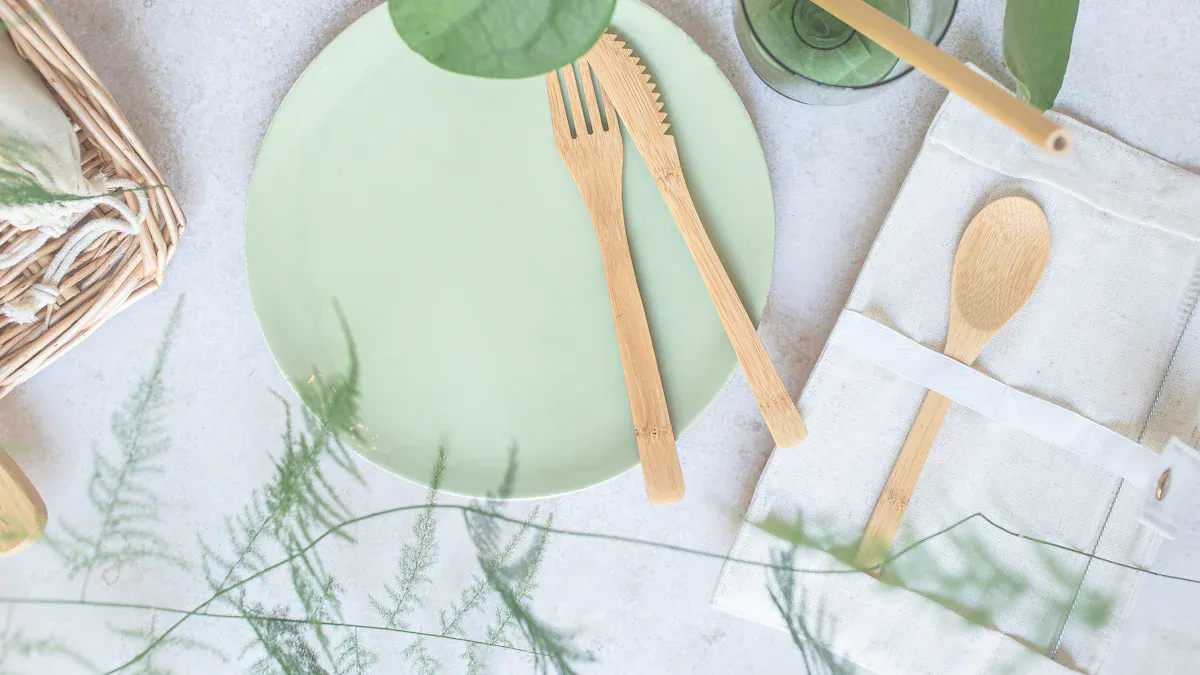
Biodegradable and Compostable Qualities
You can make a big impact by choosing bamboo plates and cutlery. These compostable plates break down quickly and return to the earth as organic matter. Research shows that bamboo plates and cutlery, especially when mixed with sugarcane fibers, are fully biodegradable and compostable. You do not have to worry about them sitting in landfills for hundreds of years. Compostable plates made from bamboo can decompose in commercial composting facilities in as little as six months, sometimes up to two years. This is much faster than plastic, which can last for centuries. When you use compostable plates, you help keep landfills and oceans cleaner. You also support eco-friendly habits that protect the planet.
- Bamboo cutlery decomposes in 6 months to 2 years in commercial composting facilities.
- Compostable plates made from bamboo enrich the soil and support sustainable agriculture.
- These plates emit less carbon when composted properly, making them an eco-friendly choice.
You can see how compostable plates offer a simple way to reduce waste and pollution. By switching to bamboo, you choose products that are biodegradable and compostable, helping nature thrive.
Reducing Reliance on Single-Use Plastics
You help reduce plastic waste every time you use bamboo plates and cutlery. Most disposable plates are made from plastic, which is not biodegradable and compostable. These items fill up landfills and pollute oceans. When you choose compostable plates made from bamboo, you lower your reliance on single-use plastics. You support eco-friendly alternatives that break down naturally. This switch helps prevent microplastics from entering water and soil. You also protect wildlife from eating harmful plastic pieces.
Tip: You can encourage friends and family to use compostable plates at parties and picnics. Small changes add up to big results for the environment.
You make a difference by choosing bamboo over plastic. Compostable plates offer a practical solution for anyone who wants to live an eco-friendly lifestyle. You help create a cleaner earth with every meal.
Lower Carbon Footprint Compared to Plastic
You can lower your carbon footprint by using bamboo plates and cutlery. Bamboo grows quickly and absorbs carbon dioxide from the air. This makes it a renewable resource for compostable plates. The production of bamboo plates creates fewer carbon emissions than plastic manufacturing. You support eco-friendly products that help fight climate change.
| Feature | Bamboo Plates & Cutlery | Plastic Plates & Cutlery |
|---|---|---|
| Biodegradability | Fully biodegradable and compostable | Non-biodegradable, takes hundreds of years |
| Resource renewability | Made from a rapidly renewable resource | Made from non-renewable petroleum products |
| Environmental impact | Lower impact, contributes to oxygen production | Harmful to wildlife, often ends up in landfills or oceans |
| Carbon absorption | Acts as a carbon sink, sequestering CO2 | No carbon absorption capabilities |
You can see that compostable plates made from bamboo have a much lower environmental impact than plastic. Bamboo plates decompose into organic matter within months, enriching the soil. Plastic alternatives take hundreds of years to break down and release harmful microplastics. Compostable plates made from bamboo emit less carbon when composted properly. You help protect the earth and support eco-friendly practices by making this switch.
You choose a product that is biodegradable and compostable, renewable, and eco-friendly. You help reduce pollution, lower carbon emissions, and support a healthier planet with every use of compostable plates.
Environmental Benefits of Bamboo Plates and Cutlery
Fast Growth and Renewability
You help the planet when you choose bamboo plates and cutlery. Bamboo grows much faster than other materials used for tableware. You can harvest bamboo in just 2 to 5 years. In comparison, wood takes more than 10 years to reach harvest size. Plastic does not grow at all because it comes from oil.
| Material | Growth Rate (Years to Harvest) |
|---|---|
| Bamboo | 2-5 |
| Wood | >10 |
| Plastic | N/A |
Bamboo stands out because it can produce up to 25 times more yield per acre than a timber forest. This means you get more material from the same amount of land. You support a renewable resource every time you use bamboo plates. The fast growth of bamboo makes it a smart choice for anyone who wants to reduce waste and protect natural resources.
Minimal Resource Requirements
Bamboo needs fewer resources to grow than many other crops. You do not need to use much water or fertilizer to cultivate bamboo for tableware. Farmers often use drip, flood, or rainwater irrigation to water bamboo. The fertilizer requirements for bamboo are much lower than for other crops. Here is a look at the typical needs for bamboo:
| Requirement Type | Quantity per Hectare |
|---|---|
| Chemical Fertilizer | Up to 1,500 kg (culm production) |
| Chemical Fertilizer | Up to 4,000 kg (shoot production) |
| Initial Fertilizer | 50 g NPK + 5 kg compost (1-2 months after planting) |
| Second Application | 100-150 g NPK + 10 kg compost (start of rainy season) |
| Final Application | 500 g NPK + 30 kg compost (start of rainy season in third year) |
| Watering Method | Drip, Flood, Rainwater Irrigation |
Bamboo farming uses less energy and creates less pollution than plastic production. Plastic requires high energy and resource consumption, which leads to more greenhouse gas emissions. Bamboo, on the other hand, has a low carbon footprint and creates minimal waste when sourced and processed responsibly.
| Aspect | Bamboo | Plastic |
|---|---|---|
| Production | Requires minimal fertilizers, pesticides, and water; has a low carbon footprint. | High energy and resource consumption, contributing to significant greenhouse gas emissions. |
| Decomposition | Fully biodegradable, breaking down in months to years. | Takes centuries to decompose and often breaks into microplastics. |
| Pollution | Minimal waste if sourced and processed sustainably. | Major contributor to land, air, and water pollution. |
You make a positive environmental impact by choosing bamboo plates and cutlery. You help save water, reduce pollution, and support sustainable farming.
Carbon Sequestration and Oxygen Production
Bamboo does more than just grow fast. It also helps clean the air. Bamboo absorbs carbon dioxide from the atmosphere and stores it in its roots and stems. This process is called carbon sequestration. Different studies show that bamboo can sequester between 12 and 18 tonnes of carbon dioxide per hectare each year. Some sources even report up to 275 tonnes per hectare from year eight onwards.
| Source | CO2 Sequestration (tonnes per hectare per year) |
|---|---|
| Happy Eco News | 12 |
| Nature | 17 |
| Springer | 13-18 |
| Science Direct | 275 (from year 8 onwards) |
Bamboo forests also produce a lot of oxygen. Some species, like Guadua bamboo, create 58% more oxygen than average tropical trees. Guadua bamboo can produce 400 tons of oxygen per hectare, while tropical trees produce about 253 tons per hectare. Moso bamboo produces about 220 tons of oxygen per hectare, which is still a large amount.
- Guadua bamboo: 400 tons O2/ha (58% more than tropical trees)
- Tropical trees: 253 tons O2/ha
- Moso bamboo: 220 tons O2/ha (about 13% less than tropical trees)
You help fight climate change and support clean air when you use bamboo plates and cutlery. Bamboo’s ability to absorb carbon dioxide and release oxygen makes it a powerful ally for the environment.
Tip: Every time you choose bamboo tableware, you support a cleaner atmosphere and a healthier planet.
Real-World Impact of Bamboo Plates and Cutlery
Statistics on Plastic Waste Reduction
You can see the difference when you choose bamboo plates instead of plastic. Bamboo plates decompose within 3 to 6 months, while plastic plates can last for hundreds of years. This quick breakdown means less waste in landfills and less pollution in the environment. When you use bamboo, you help reduce the amount of trash that ends up in oceans and on land. Here is a comparison to show how bamboo plates help the earth:
| Feature | Bamboo Plates | Plastic Plates |
|---|---|---|
| Biodegradable | Yes (3-6 months) | No (hundreds of years) |
| Compostable | Yes | No |
| Renewable Resource | Yes | No |
| Environmental Impact | Reduces landfill waste | Contributes to pollution |
By switching to bamboo, you support a cleaner planet and help lower the amount of harmful waste.
Community Initiatives and Global Adoption
Many communities around the world have started using bamboo plates and cutlery to protect the environment. You can join these efforts in several ways:
- Choose FSC-certified bamboo products to support responsible forest management.
- Educate your friends and family about the benefits of sustainable products.
- Get involved with organizations that promote forest conservation by volunteering or spreading the message.
These actions help conserve resources, reduce landfill waste, and prevent pollution. When you use biodegradable bamboo utensils, you support the global movement toward sustainable dining and responsible consumption.
Tip: Every time you pick bamboo tableware, you join a worldwide effort to care for the earth.
Everyday Choices That Add Up
Your daily choices matter. When you use bamboo plates and cutlery, you help return valuable nutrients to the soil through composting. This process enriches the earth and supports plant growth. Bamboo comes from a renewable resource, so you help protect forests and reduce your environmental impact. Here are some ways your choices make a difference:
- Bamboo plates decompose quickly, reducing landfill waste.
- Using bamboo shows your commitment to reducing pollution.
- Choosing bamboo supports a sustainable lifestyle.
You play a key role in building a cleaner, greener future. Small steps, like using bamboo plates, add up to big changes for the planet.
Addressing Common Concerns About Bamboo Plates and Cutlery
Sourcing and Ethical Production
You may wonder how companies source bamboo for plates and cutlery. Responsible sourcing matters because it protects forests and workers. When you choose bamboo products, look for these important features:
- Companies that use fair labor practices and harvest bamboo in a sustainable way help protect the environment and local communities.
- Certifications like FSC (Forest Stewardship Council) and Rainforest Alliance show that the bamboo comes from responsibly managed forests.
- Products finished with food-safe oils or natural waxes keep your meals safe and healthy.
By checking for these qualities, you help ensure that your bamboo tableware supports ethical production and environmental care.
Durability and Usability
You might ask if bamboo plates and cutlery are strong enough for daily use. Bamboo is a tough material, making it a good choice for short-term use at parties, picnics, or family gatherings. Here are some facts to consider:
- Bamboo cutlery is strong and durable for most meals, but it can wear out faster than plastic if used for heavy-duty tasks.
- Plastic cutlery, especially made from polypropylene, resists bending and breaking under pressure or heat.
- Bamboo is eco-friendly and safe for food, but it is best for light to medium use.
You can rely on bamboo plates and cutlery for most occasions, knowing you are making a choice that helps the planet.
End-of-Life Disposal and Composting
When your bamboo plates and cutlery reach the end of their life, you have eco-friendly options for disposal. Proper composting helps bamboo break down quickly and return nutrients to the soil. Here is a table to show how you can dispose of bamboo tableware:
| Disposal Method | Description |
|---|---|
| Biodegradable | Bamboo plates and cutlery break down naturally in the environment. |
| Compostable | They can be composted within 2–6 months under the right conditions. |
To compost bamboo at home or through a municipal program, follow these steps:
- Use a composting system that can handle bamboo materials.
- Break larger pieces into smaller parts to speed up decomposition.
- Keep your compost pile balanced with green and brown materials, moisture, and air.
- Make sure your bamboo products do not have non-biodegradable coatings.
Look for certifications like BPI or CMA to confirm your bamboo plates and cutlery are compostable. By disposing of bamboo properly, you help reduce waste and support a cleaner earth, truly supporting sustainable living.
You can help protect the planet by choosing bamboo plates and cutlery. Many people have already made this switch and seen real results. For example, a large wedding used bamboo cutlery and bagasse plates. Guests liked the sustainable choice and the plates worked well. Fast-food chains that switched to bamboo and bagasse improved their brand image and made customers happier.
| Example | Result |
|---|---|
| Wedding with bamboo tableware | Guests praised sustainability and quality |
| Fast-food chain switch | Better brand image and customer satisfaction |
Every time you pick bamboo, you support a cleaner earth. Your choices matter.
FAQ
What makes bamboo plates and cutlery eco-friendly?
Bamboo grows fast and needs little water. You help the earth by choosing products that break down in months. Bamboo plates and cutlery do not create microplastics. You support a cleaner planet with every use.
Can you reuse bamboo plates and cutlery?
You can reuse some bamboo plates and cutlery if you wash them gently. Most are designed for single use at parties or events. Always check the product label for reuse instructions.
How do you compost bamboo plates and cutlery?
You can add bamboo plates and cutlery to your compost pile. Break them into small pieces. Mix with green and brown materials. In commercial composting, bamboo breaks down in 2–6 months.
Tip: Remove any coatings before composting for best results.
Are bamboo plates and cutlery safe for food?
You eat safely with bamboo plates and cutlery. Manufacturers use food-safe oils or waxes. Many products meet FDA standards. You can check for certifications like BPI or FSC for extra assurance.
| Certification | What It Means |
|---|---|
| BPI | Compostable verified |
| FSC | Responsible sourcing |
| FDA | Food safety approved |


